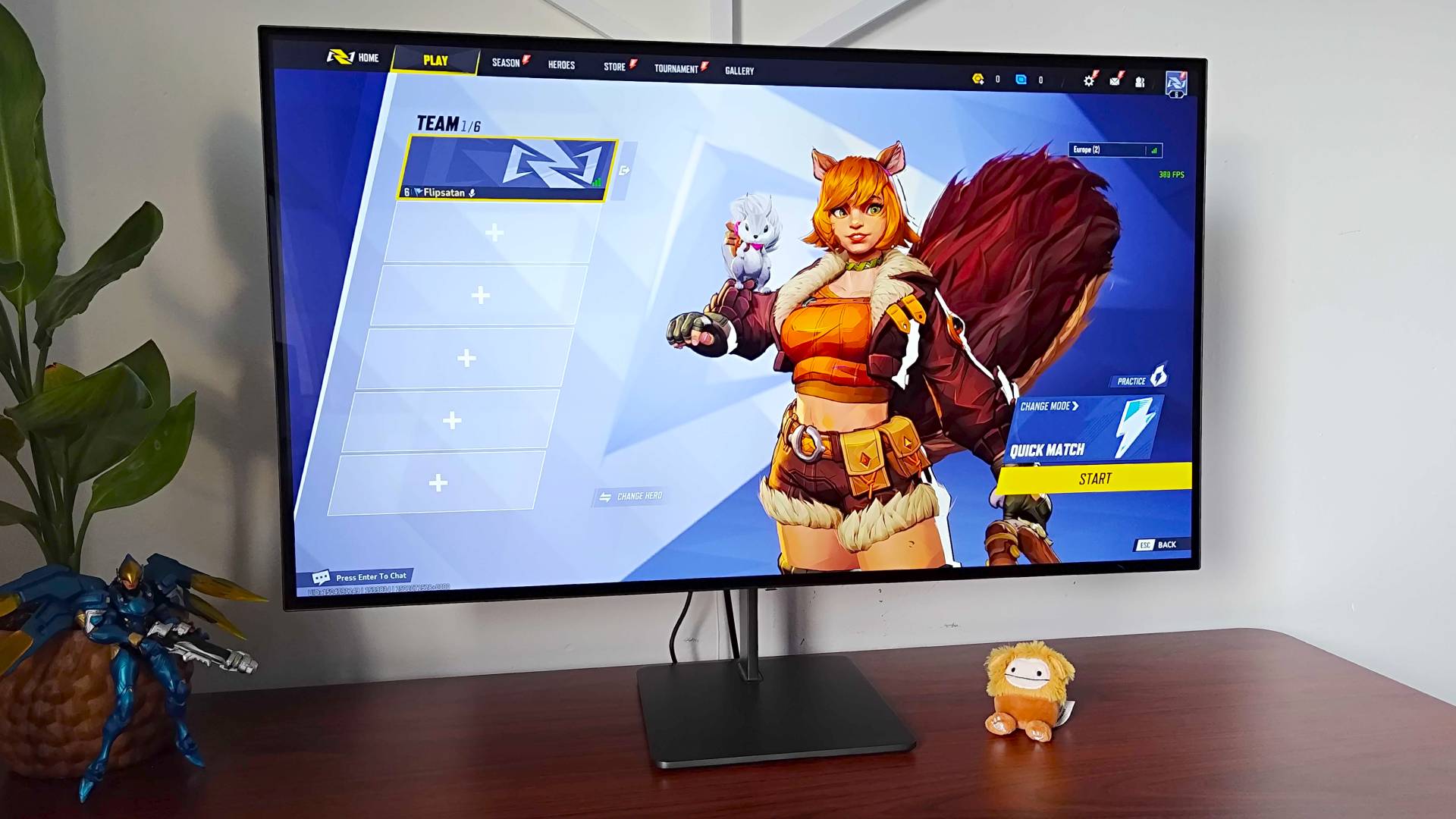GamesRadar+ Verdict
The Dough Spectrum Black 32 offers up a gorgeously glossy 4K display and excellent 1080p 480Hz dual model abilities, but its firmware and HDR results are a little finicky. While both those issues will likely receive fixes in the future, it does prevent it from currently claiming the UHD gaming monitor throne.
Pros
- +
Great dual resolution abilities
- +
Fantastic colors and contrast
- +
Enhanced visuals via glossy Gorilla Glass
- +
Competitive price
Cons
- -
Firmware needs some extra work
- -
HDR issues
Why you can trust GamesRadar+
I feel like I’m in a bit of a situationship with the Dough Spectrum Black 32. One minute I’m head over heels for its glossy 4K gorilla glass-coated panel with dual resolution capabilities, the next I’m throwing all of its hypothetical clothes out of the window in response to its finicky firmware. This is certainly one of the first gaming monitors by the company I’ve tested that comes close to a perfect score, but small quirks keep it from being a dreamboat display.
Dough Spectrum Black 32 prices start at $899 for the matte version, and that’s honestly not half bad for a 31.5-inch 4K 240Hz dual-resolution that rivals the best gaming monitor options. It’s a chunk cheaper than my current favorite screen, the LG Ultragear 32GS95UE, despite using the exact same WOLED panel, not to mention the $1,099 model I’ve been testing boasts that extra layer of glossy Gorilla Glass. You’d think that would help it steal the crown, I mean, I was rooting for it. However, when you combine those aforementioned firmware issues with the fact it doesn’t come with a stand, LG’s own screen still comes out tops.
Before anyone gets the wrong idea, the Dough Spectrum Black 32 is one of the best 4K monitors for gaming. It also happens to be a killer 1080p screen since it can moonlight as a 480Hz panel. I’m just not sure most players should buy it by default over the Ultragear 32GS95UE as, while both experiences are fairly close, Dough’s display isn’t quite as tight.
Specs | Dough Spectrum Black 32 |
|---|---|
Price | From $899.99 |
Panel type | OLED |
Screen size | 31.5-inch |
Aspect ratio | 16:9 |
Resolution | 3,840 x 2,160 (1920 x 1080 dual mode) |
Refresh rate | 240Hz (480Hz dual mode) |
Brightness | 1000 nits |
Viewing angles | 178°/178° |
Contrast ratio | 1500000 : 1 |
Ports | 2 x HDMI 2.1, 1 x DisplayPort 1.4, 1 x USB-C (updates only), 3.5mm audio jack |
Design

Dough monitors tend to look more like professional Apple-esque screens than gaming displays, and the Spectrum Black 32 is no different. The screen maker started leaning into the Apple Studio vibe with the Spectrum Black 27, and it makes a nice change from brands forcing RGB lighting and weird ridges into aesthetics as a check box exercise.
From the front, the Spectrum Black 32 keeps things fairly conservative. We’re talking about a black rectangle with a not-quite edge-to-edge design, thanks to the usual black border around OLED screens. It’s slick, but not exactly what I’d call a head-turner even with its optional square pedestal stand attached. What it does embody, however, is a premium vibe that will add an element of elegance to your gaming desk setup using a blend of metals and high-quality plastics.
The back sings a similar tune, keeping most of the guts to a rectangular hump while keeping everything else pretty thin. The monitor’s ports also fire outwards rather than being tucked under a lip since the protruding parts of the case are flush with the bottom, but I much prefer this approach since it makes hot-swapping cables out from the front easier.
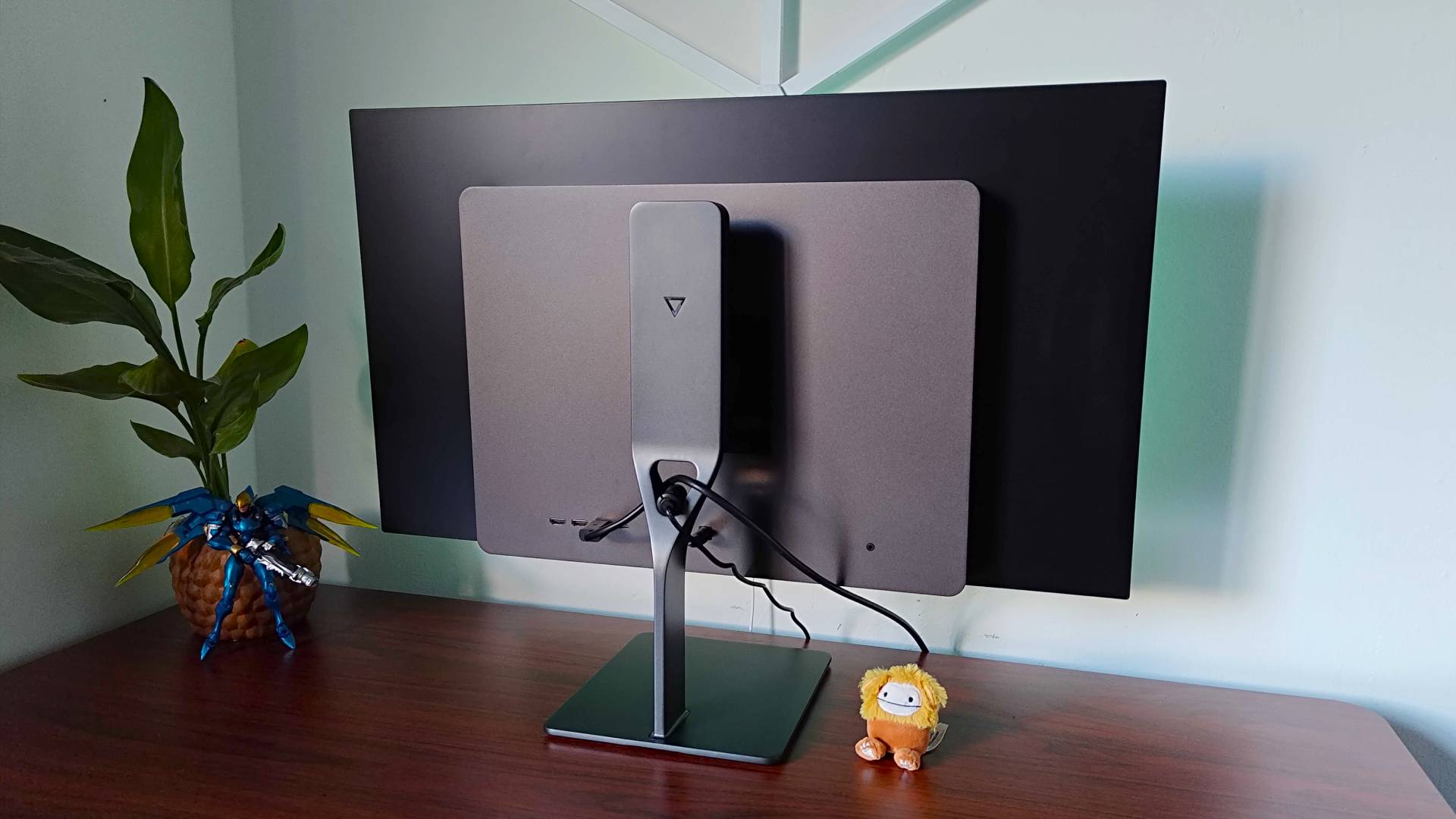
You’ll find the OSD controls, power button, and dual resolution toggle in that bottom region too, and yes, it uses one of those dreaded menu joysticks. While the buttons on the Spectrum Black 27 used to face outwards on the back, they’re now underneath the front, which does result in less fumbling around. Does that help the OSD nub control a little better? Actually, no, as it’s smaller this time around, which means I can’t quite grip the edges with my finger as well for enhanced tactility.
I’d occasionally find myself accidentally pressing one of the directional shortcuts for things like crosshairs and source input rather than a center press, which is incredibly annoying. If Dough, or any other monitor maker for that matter, wants to stop me moaning about this in every review, I’d start adding in a small remote control. I get that there are cost implications, but it’s the sort of luxury I want from a premium monitor in 2025.
Features
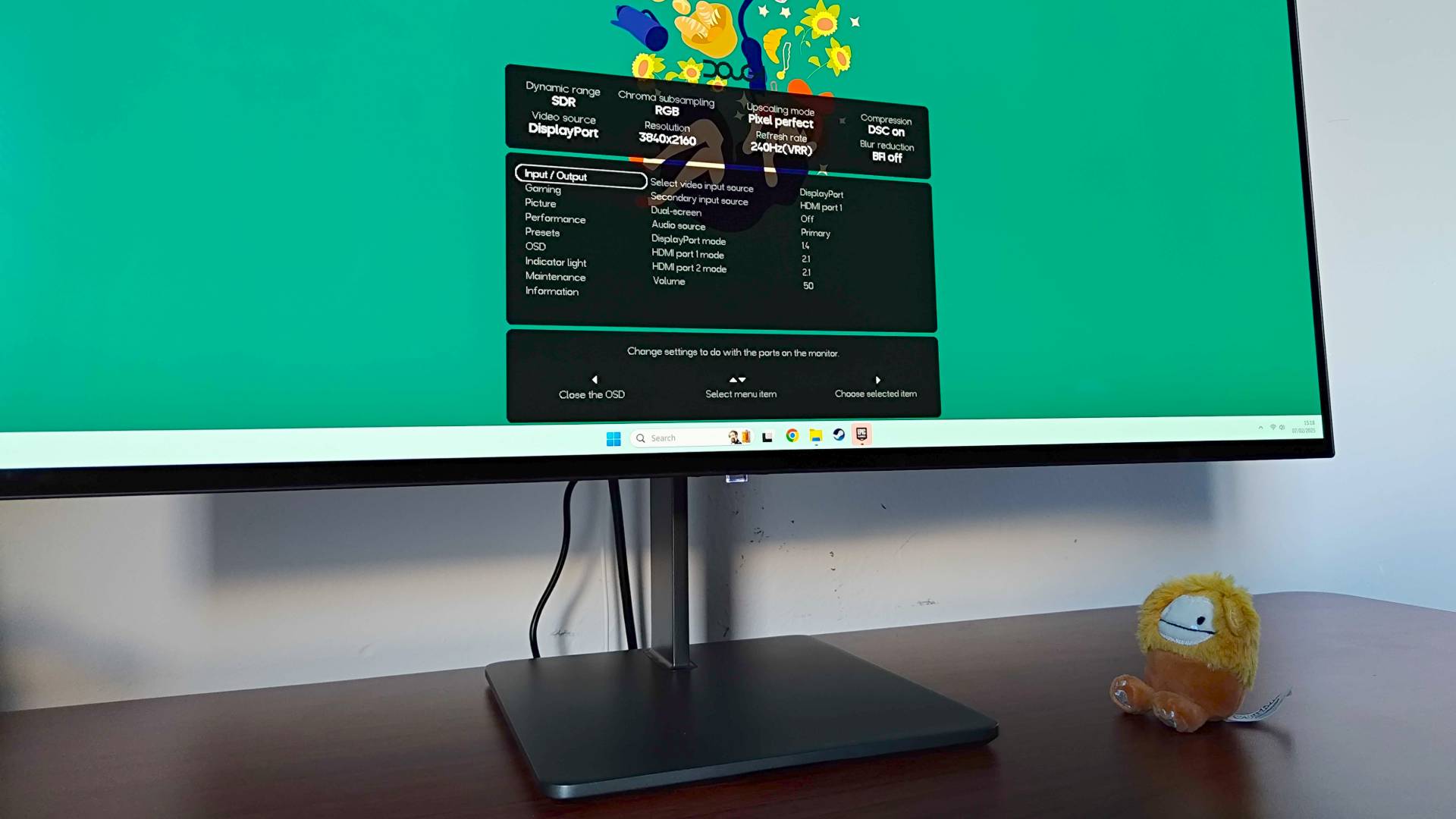
Dual-resolution monitors are all the rage going into 2025, and I’m totally here for it. Being able to (sort of) instantly hop between 4K 240Hz and 1080p 480Hz should save you thinking about buying a high refresh rate monitor for years to come, and the Dough Spectrum Black 32 fully embraces that.
Of course, it’s far from being the first 4K 240Hz dual-resolution monitor on the market, and just like its rivals, it's ultimately a spin on the LG Ultragear 32GS95UE. That’s less a case of Dough copying homework and more the company adding some enhanced spice, or at least that’s the case with the glossy Gorilla Glass version. If you pick up the base model, you’re getting something that’s incredibly close to LG’s WOLED screen, whereas the top model adds a USB-C hub with power delivery into the mix.
The model I’m testing sadly lacks the USB-C extras, which means no fooling around with gaming handhelds and using single-cable Power Delivery abilities. It’s a future that’d be nice to have, but you can grab a Steam Deck dock for less than the difference between models ($1,099 versus $1,299), although you’re getting DisplayPort 2.1 instead of 1.4 with that yet-to-be-released variant.
But hey, I can only speak for the non-USB-C glossy model, so let’s dive into what it offers beyond dual-resolution. The panel itself is armed with LG’s MLA+ tech, the same feature that earns the LG OLED G4 the best gaming TV crown, FreeSync Premium Pro, Variable Refresh Rate, and HDR True Black 400 support. On top of that, you’re getting a myriad of maintenance settings that ensure burn-in is never an issue, including logo extraction algorithms, menu bar detection, and even a “transistor wear compensation” option that’ll help prevent image retention even as the hardware starts to suffer from old age.
I don’t want to dunk on the number of options in the Spectrum Black 32’s OSD, but it is a little overwhelming. The menu is packed to the brim with features most players might not even have a second thought about, which does hammer home the screen’s enthusiast market. That’s both a good and a bad thing, as it makes the monitor extremely customizable while making general use a little harder and increasing your chances of weird quirks.
Performance
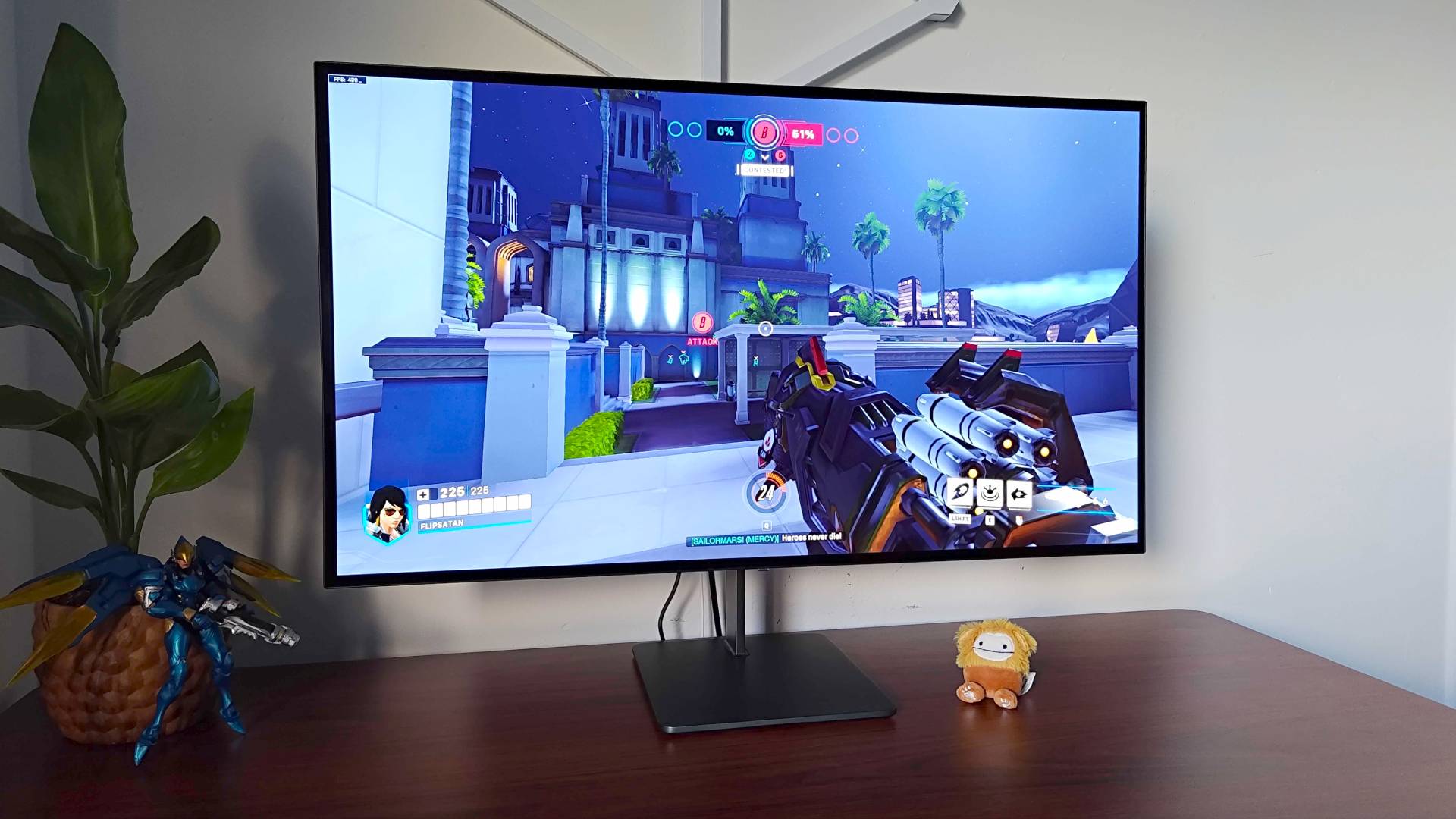
Here’s where things with the Dough Spectrum Black 32 get interesting, as it offers up killer 4K capabilities laced with glossy goodness. However, I came across multiple instances of the monitor’s firmware being a pain, and while it didn’t completely hamper things on a visual level or make the screen completely unusable, it left me feeling like the dough had to go back in the oven.
Starting with HDR, I initially had to install a firmware update to tackle issues with brightness. The fix worked, but High Dynamic Range content seems to still feel a little off on this screen. Windows 11 normally looks a little weird at first with the setting switched on, but even after some calibration and playing around with color options, tone mapping seems to be providing inconsistent results. I found myself switching HDR off in those instances, but it's another step I’d rather not have to take to use the feature.
My second gripe is a bit of a weird one, and it may very well be a one-off. After a few weeks of using the screen’s dual resolution toggle without a hitch, I found that it’d no longer jump from 4K 240Hz to 1080p 480Hz. I was still able to switch resolutions in the OSD, but the fact the button wouldn’t work was grating, to say the least. The issue still remained following both a reset and reinstalling firmware, which made me think something had gone seriously wrong.
I eventually managed to fix things by switching the toggle in the menu to another function and then back again. I’m not sure why resetting things didn’t produce the same results, and I’m willing to admit that it could have been either a one-off or something that occurred during testing. For that reason, I’m not going to hold the instance against the Spectrum Black 32, but it’s worth recording the blip so that I can stop gaslighting myself.
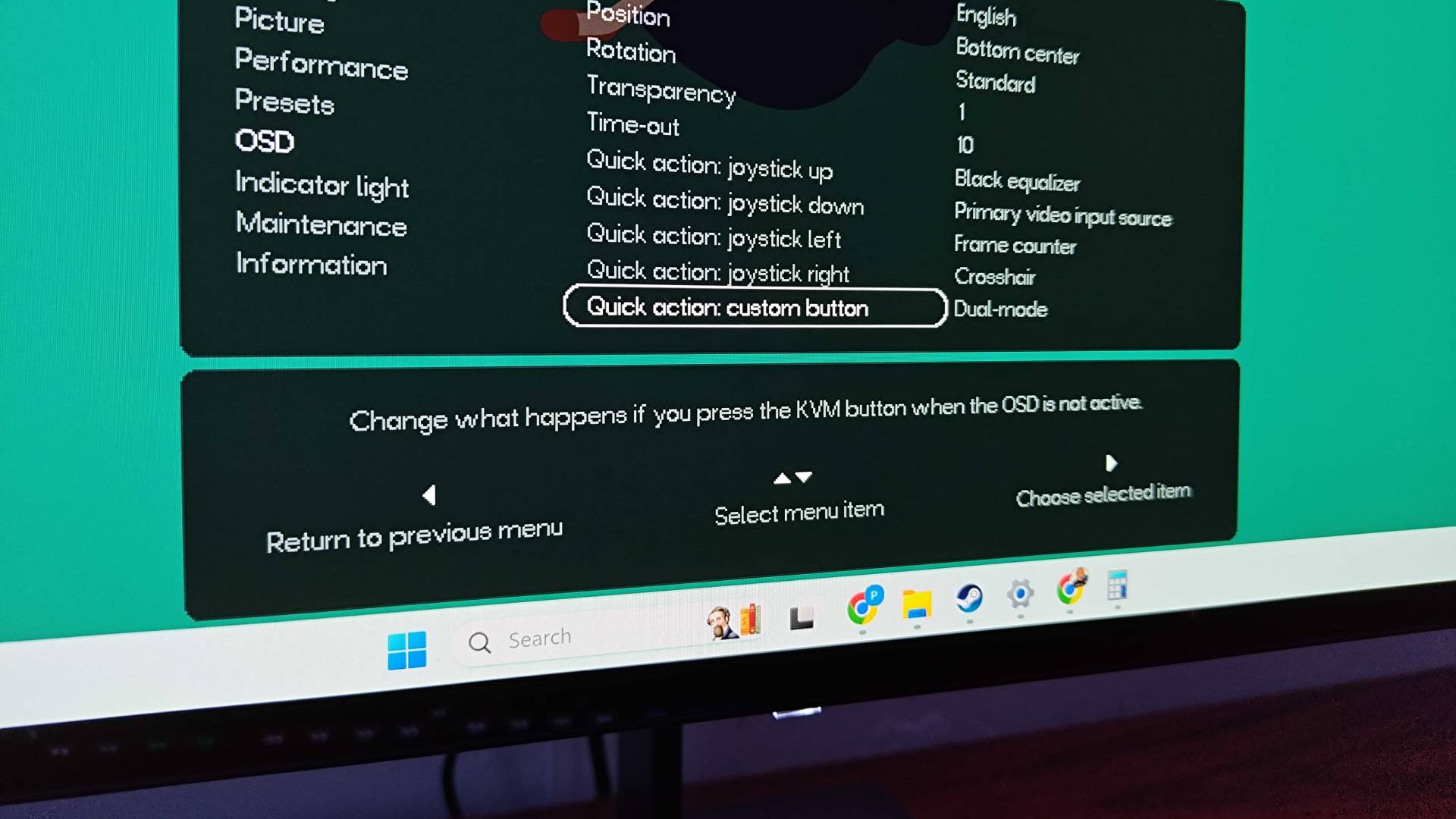
I eventually managed to fix things by switching the toggle in the menu to another function and then back again. I’m not sure why resetting things didn’t produce the same results, and I’m willing to admit that it could have been either a one-off or something that occurred during testing. For that reason, I’m not going to hold the instance against the Spectrum Black 32, but it’s worth recording the blip so that I can stop gaslighting myself.
Okay, on to the pros of using the Dough Spectrum Black 32, as they thankfully outweigh the cons. Just like with the Spectrum Black 27, the display takes a physical approach to elevating contrast using a glossy screen, building on top of the vibrancy already provided by the wonderful OLED panel within. This naturally helps 4K visuals pop even harder when put to good use, but I’m pretty impressed with how it benefits 1080p 480Hz scenarios too.
For my sins, I still play a lot of Overwatch 2. I’ve become accustomed to playing the shooter at 1080p since it enables me to boost fps to match even the fastest monitors out there. Hitting 480fps to match the Spectrum black 32’s max refresh rate is pretty easy, but the thing that caught me off guard before taking off as Pharah was how nice the visuals remain compared to 4K.
Yes, there are some jaggies and softness when playing at 1080p, and using a 32-inch monitor exacerbates that. However, I found myself noticing it less thanks to the gorilla glass coating, as it helped highlight the visuals and colors regardless. I will admit that 1080p mode isn’t designed for leisurely walks, the whole point is that you’ll be able to treat this screen like an esports screen. And I certainly did just that playing competitively at 480Hz, but the setup does go the extra mile to help even its fastest visuals look nice.
For a change, I’ve also been giving Marvel Rivals a go, and while it’s much harder to hit 480fps consistently in that shooter, even with an Nvidia GeForce RTX 5080, the screen’s responsiveness came through. 0.03ms GtG response times are a staple of OLED displays at this point, and it does give the Dough Spectrum Black 32 an advantage over IPS and VA rivals. That’s not to say I’ve been playing the comic book romp like some sort of esports pro since I mainly just cause chaos as Squirrel Girl, but speed still helps firing nuts and critters around the map feel more enjoyable.
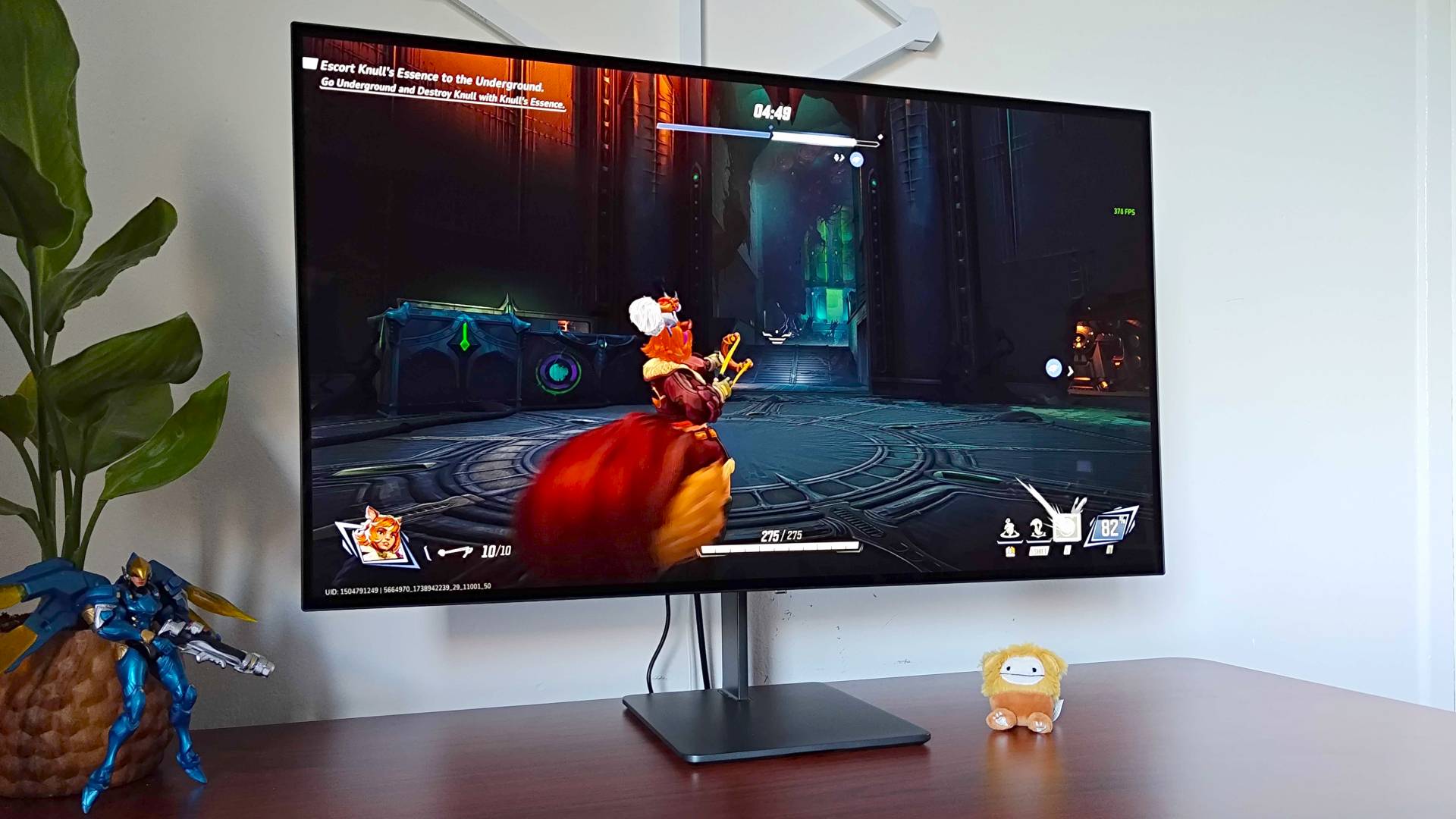
The funny thing about dual-resolution monitors is that 4K 240Hz could also be considered suitable for competitive play. It feels like only yesterday that anything above 165Hz was considered ultra-fast, and since some games aren’t good at matching higher refresh rates with an appropriate frame rate, some of you might not benefit from the resolution-switching toggle. I happen to think being able to hot-swap between two different screen configurations is pretty game-changing, but I’d say it fully depends on the games you play and your PC configuration.
At 4K, the Dough Spectrum Black 32 hammers home the benefits of glossy gaming monitors. The extra sharpness provided with UHD resolutions is highlighted by the screen type, with text popping and textures standing out that bit more compared to a matte panel. When HDR isn’t misbehaving, it pairs with the coating to produce beautiful results, and I was pretty taken mersmurized upon checking out the streets of Night City with Cyberpunk 2077’s RT Overdrive mode switched on. Ray-traced reflections and the glow of neon lighting excel on glossy screens like this, and the elevated richness certainly enhances immersion.
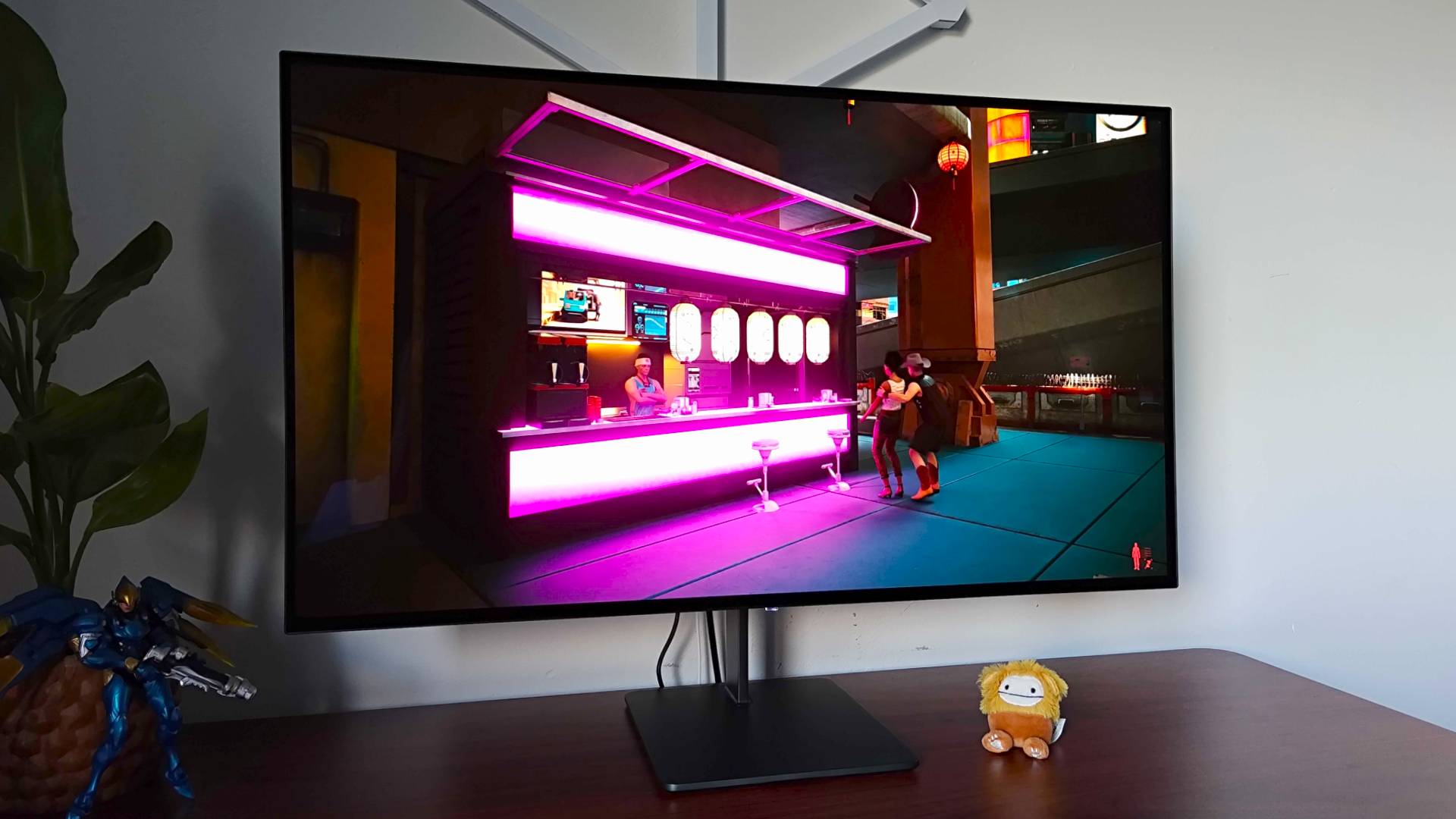
I ended up testing the Dough Spectrum Black 32 alongside the brand new Nvidia GeForce RTX 5080, which allowed me to check out fresh releases like Dragon Age: The Veilguard for the first time. Let’s just say that I’m glad my eyes got to experience the fantasy outing on this glossy screen first since it breathes extra life into Bioware’s latest RPG romp. The adventures’ detailed textures and role-playing text elements all punch harder thanks to the Gorilla Glass gloss, and the same benefits apply across the genre. Considering I had a blast playing Baldur’s Gate 3 on the 27-inch QHD version, it’s safe to say that ramping things up to 4K will only make the D&D epic more magical.
I’d love to say that there are no caveats tied to glossy monitor coatings. For what it’s worth, Dough does a nice job combating existing cons, but the 32-inch Spectrum Black is a bit more susceptible to glare than its 27-inch sibling. The screen fairs much better with HDR switched off and brightness cranked to max, but the extra surface space manages to catch more reflections otherwise. I sit next to a fairly bright window, so my tests are a little more brutal than other usage scenarios. Nevertheless, being able to see the outside world in the top-left corner had me pining for the anti-glare superpowers of the Samsung Odyssey OLED G6.
Should you buy the Dough Spectrum Black 32?
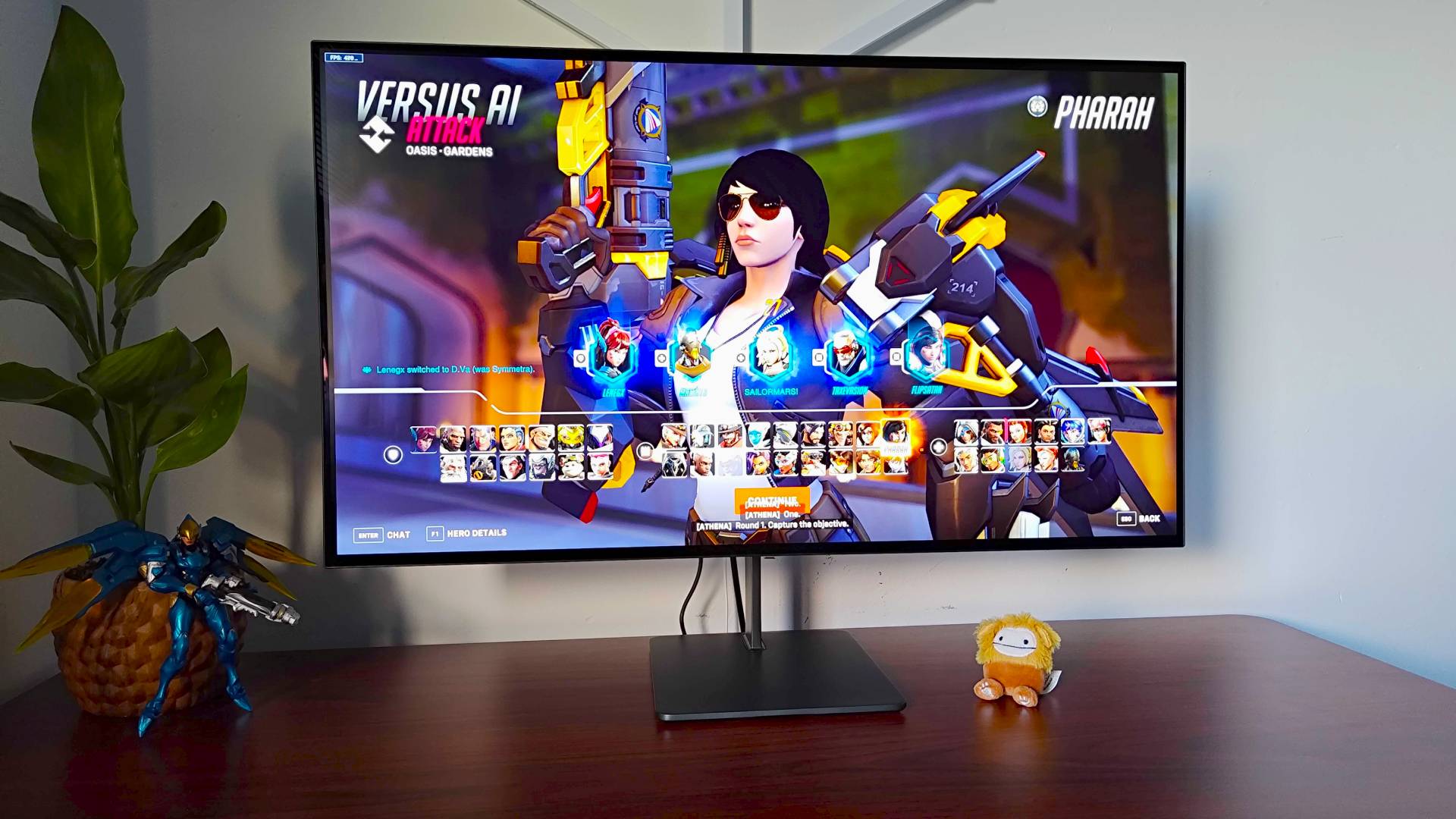
The Dough Spectrum Black 32 is a 4K heavy hitter that takes the dual-mode gaming monitor format and revamps it with glossy Gorilla Glass. It’s certainly a display designed with fidelity enthusiasts in mind, and its elegant design, excellent build quality, and abundance of protective OLED measures will help it stand the test of time. Sadly, finicky firmware ultimately keeps the screen from taking the crown right now, as quirks with HDR and functionality keep perfection out of reach.
Again, I do consider the Spectrum Black 32 to be one of the top 4K gaming monitors out there right now. The main issue is that it shares DNA with screens like the LG UltraGear 32GS95UE that feel like a more rounded experience. If you’re looking for 4K visuals with an extra kick, opting for the glossy model is well worthwhile. Otherwise, you’ll want to go straight to LG’s model for reliable HDR and extras like built-in speakers.
How I tested the Dough Spectrum Black 32
For two weeks, I used the Dough Spectrum Black as my main gaming monitor for casually playing games and benchmarking graphics cards. During that time, I tested the display’s dual-resolution capabilities by running Cyberpunk 2077 and Dragon Age: The Veilguard specifically with 4K Ultra settings enabled while also playing Overwatch 2 and Marvel Rivals at 1080p 480Hz. To assess brightness capabilities, I assessed the screen both in daylight and in a darkened room, which also helped provide insight into any glare with the glossy coating.
For more information on how we test gaming monitors and other displays, check out our full GamesRadar+ hardware policy.

I’ve been messing around with PCs, video game consoles, and tech since before I could speak. Don’t get me wrong, I kickstarted my relationship with technology by jamming a Hot Wheels double-decker bus into my parent’s VCR, but we all have to start somewhere. I even somehow managed to become a walking, talking buyer’s guide at my teenage supermarket job, which helped me accept my career fate. So, rather than try to realise my musician dreams, or see out my University degree, I started running my own retro pop culture site and writing about video games and tech for the likes of TechRadar, The Daily Star, and the BBC before eventually ending up with a job covering graphics card shenanigans at PCGamesN. Now, I’m your friendly neighbourhood Hardware Editor at GamesRadar, and it’s my job to make sure you can kick butt in all your favourite games using the best gaming hardware, whether you’re a sucker for handhelds like the Steam Deck and Nintendo Switch or a hardcore gaming PC enthusiast.
